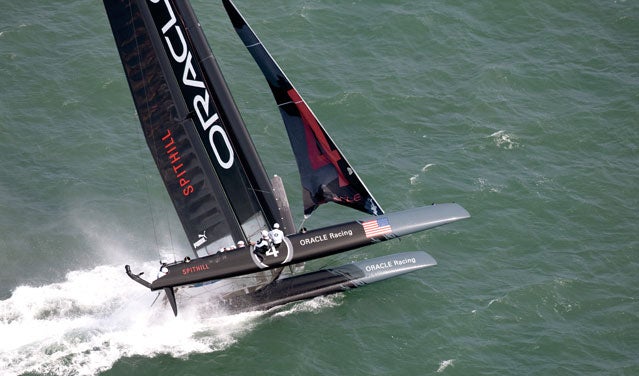RUSSELL COUTTS DIDN’T plan his violent crash on the San Francisco Bay, but his timing was almost perfect. It was June 2011, and Coutts, a 50-year-old New Zealander and four-time winner of the America’s Cup, was showing off a new type of ultralight, high-speed catamaran at a media event. During a morning presentation, the journalists were told that the boats, made mostly of carbon fiber and powered by giant, rigid wing sails, would transform the , to be held on the bay in 2013, into a thrilling sport with “a significant amount of risk.” Sailors would need to be extremely fit and were required to wear helmets. There would be accidents.
AC World Series
 The tight World Series courses “change the sport from a defending game to an attacking game,” as one Oracle official explained it.
The tight World Series courses “change the sport from a defending game to an attacking game,” as one Oracle official explained it.Six hours later, Coutts flew helmet-first through the shrink-wrap-like transparent skin of his wing sail. He’d been at the helm during a practice race when he buried the bows into the waves at 22 knots—roughly 25 miles per hour—and . The wing sail hit the water first, causing the hulls to pirouette in midair before smashing down on one side. Three of the five sailors aboard held on, but Coutts was flung through the wing. He emerged unscathed, but another crew member fell from the stern and suffered dislocated rib cartilage. A photo of the wipeout made the front page of the San Francisco Chronicle the next day, and a .
And just like that, the rebranding of the America’s Cup was under way.
It’s always been an upwind battle to build a mainstream audience for sailing, but in recent years a litany of lawsuits between billionaire team owners over the Cup’s byzantine rules regarding boat design gutted the race’s fan base. U.S. television networks ignored , held in Valencia, Spain, and even hardcore yachting fans have abandoned ship. As the CEO of , the American team that won the 2010 Cup, Coutts is tasked with rebooting the race in advance of the next edition. The project starts with catamarans that are twice as fast as classic monohulls, highly prone to capsizing, and capable of performing in extremely light winds—meaning no TV-killing race delays. And the events will no longer be held offshore but in smaller bodies of water, with shoreline access for crowds and tighter racecourses that force action.
“The danger factor is just one piece of the puzzle,” says Coutts.
Right: the biggest piece.
IN 1987, won the America’s Cup during live coverage on ESPN, three years after becoming the first American to lose it since the race was first held in 1851. His victory lap included the covers of Time and Sports Illustrated (the latter ). That was the peak. By 2007, after years of declining ratings, ESPN ceded rights to Versus. The 2010 Cup wasn’t televised in the U.S. at all.
That year Oracle Racing, which is owned by the software mogul Larry Ellison, captured the Cup with a mammoth 90-by-90-foot wing-sail-powered trimaran that looked like something stolen from the set of Star Trek. As the new Cup defender, Ellison was granted the power to rewrite the race’s rules so long as the challenger of record agreed to them. (You can see where the lawsuits start.) His protocol for the 34th Cup called for a complete reboot: all challengers would race the 2013 contest in the same ultralight 72-foot wing-powered catamarans, dubbed AC72s, with only minor allowances for adaptations. The teams would also be required to enter the , a two-year international circuit raced on more forgiving 45-foot boats, called AC45s, so sailors could adapt and engineers would have time to figure out the giant AC72—and so Ellison’s operation could market the new breed of sailing to the public and potential sponsors. His goal was “to convert sailing into an extreme sport.”
For traditionalists, who blamed the Cup’s downturn on the intrusion of multihulls, the X Game–ification was sacrilege, akin to switching Tour de France cyclists to e-bikes. Ellison’s rival from 2010, Swiss-Italian Team Alinghi owner Ernesto Bertarelli, decided to withdraw entirely, determining that he had no chance of victory under the new rules. One blogger bemoaned the coming era of “drag racing.” It was only a slight exaggeration. The AC45 has proven capable of moving up to three times as fast as the available wind, with a top speed of 45 miles per hour, thanks mostly to its wing sail, a rigid but maneuverable structure that has flaps like an airplane wing and provides significantly improved power-to-drag ratio over soft sails. Catamarans also don’t require the massive lead keels that monohulls use to stay upright. Instead they skim across the surface of the water and often “fly” one hull into the air. This makes a boat like the AC45 more fun to watch but also a hell of a lot harder to control.
Ellison’s first move to lure back broadcasters (and sponsor dollars) was to pour cash into a video production unit. By the first World Series event in Cascais, Portugal, last August, there was a 100-person team on site, with cameramen patrolling the water in helicopters and chase boats. Each AC45 was outfitted with four onboard cameras. On the , viewers could switch between cameras and listen to commentators or raw audio from mic’d-up sailors. Studio technicians superimposed digital graphics on the footage—think of those first-down markers in NFL games—to identify wind direction, course boundaries, and angles of attack.
The result is an energizing spectacle that plays out on your screen like a watery Nascar race. Each of the nine teams in the series flipped at least once in the first two events. At the second stop, in Plymouth, England, in September, winds gusted to 35 knots. During a practice session, Team China cartwheeled into the sea, shredding its wing sail. In the five-minute countdown before one fleet race, the boats were jockeying at the starting line to secure the optimal angle to the wind when the French-backed Team Aleph rammed into the hull of Spanish team Green Comm Racing. Moments after the two untangled, Team Artemis of Sweden crashed into Green Comm as a commentator shrieked about the .��
THAT PILEUP WAS ON MY MIND as I hung on to the back of Artemis’s AC45 in San Diego in mid-November during a practice race before the first U.S. event in the World Series. In another move aimed at seducing the media, each catamaran reserves a spot for a guest racer at the rear of the netting spanning the twin hulls. In the tense scrum leading up to the starting gun, skipper Terry Hutchinson played increasingly daring games of chicken with the other boats. Once the race was under way, the action spread out, but not much. Classic America’s Cup races have been determined largely at the start: boats that fought to secure the best positions then battled to maintain their advantage until the finish. But the tight World Series courses, which ignore conventional relationships with the wind, “change the sport from a defending game to an attacking game,” as one Oracle official explained it.
Crouched at the back of the netting, I learned to brace for blastoff every time we turned downwind. The five Artemis sailors, wearing skintight leggings and tops, looked like 21st-century gladiators and acted the part. At one point, Hutchinson barked, “No! No! No!” at Team Korea as they encroached on our right of way. At another, crew member Morgan Trubovich leaped into the air, yanked a line, and fell with it to the deck, deploying a secondary sail. To make the transition from monohull racing, sailors on all the teams have been doing serious endurance and agility conditioning. According to the Artemis trainer, they burn up to 4,500 calories during several hours of racing.��
One of the course markers was placed close enough to shore that I could stare into the camera-phone lenses of tourists who’d paid to visit the but now stood glued to the retired carrier’s bow, transfixed by the wild show on the water. The wind was blowing at a modest seven to ten knots, but the AC45s were still flying hulls and skipping across the bay like giant metallic bugs. The wing sails are so efficient at generating power that you can race in just five knots of breeze. At the top end, they can handle 30 knots before you lose control altogether. By contrast, the monohulls of past Cups required between nine and 22 knots, which led to delays lasting from hours to weeks.��
“When you look at the [2000] America’s Cup in New Zealand, the racing was delayed 15 days,” says Coutts. “That’s just crazy. You can’t tolerate that from a commercial standpoint.”
Coutts eagerly admits that the AC45 was designed to be tough to sail. The fact that teams are allowed only five sailors on a boat that could use seven makes it even tougher. “The fewer people you have, the more difficult it is,” he says. “And the more catastrophic when you get something wrong.”
So far, the catastrophes have resulted only in minor injuries and lots of boat repairs. But make no mistake: it’s the element of danger—the sense that another catamaran cartwheel is just around the next mark—that will get people to watch sailing again. The first World Series event, in Cascais, was broadcast in 130 countries and territories. By San Diego, that number was 197. America’s Cup officials say they’ve reached an agreement with a major network for live coverage of the 2013 Cup, plus a World Series race in 2012, either Newport, Rhode Island, in July, or San Francisco in August.
By then the sailors will be much more comfortable on their AC45s—just in time to start testing the first AC72s. Their wing sails will be twice the height, and the boats should be able to reach nearly 50 miles per hour—though it’s an open question whether the allotted 11-man crews will be able to handle them at that speed. When I asked Artemis’s Trubovich about a worst-case scenario on the bigger boats, he averted his eyes and said, “One day, someone is going to fall through the wing and not have an OK landing.”
Which, of course, would be great for ratings.


